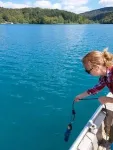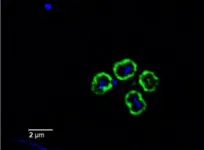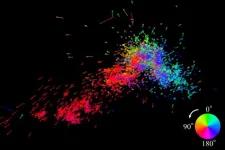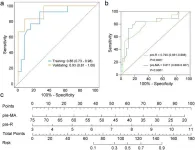(Press-News.org) Bacteria play key roles in degrading organic matter, both in the soil and in aquatic ecosystems. While most bacteria digest large molecules externally, allowing other community members to share and scavenge, some bacteria selfishly take up entire molecules before digesting them internally. In a paper publishing April 10 in the Cell Press journal Cell Reports, researchers document “selfish polysaccharide uptake” in freshwater ecosystems for the first time. In Croatia’s Kozjak and Crniševo Lakes, they found that nutrient hoarding allows selfish species to dominate over others, which could shape a lake’s food web—and these dynamics will likely shift due to climate change, especially in cold lakes.
“Bacteria play a crucial role in nutrient cycling in lakes by degrading polysaccharides, and their ability to selfishly consume these compounds influences the availability of carbon and other nutrients in the ecosystem,” says first author Andrea Čačković of the Ruder Bošković Institute.
To explore the role of selfish microorganisms in freshwater systems, the researchers compared two different lakes in Croatia: the northerly Kozjak Lake, the largest and deepest lake in Plitvice Lakes National Park, and the more southerly Crniševo Lake. Whereas Kozjak Lake is oligotrophic (i.e., has low levels of nutrients and algae) and freezes over in the winter, Crniševo Lake is in a mediterranean climate and is mesotrophic (i.e., has higher levels of nutrients and algae).
The team collected water samples in the spring and summer of 2022 and the winter of 2023 and quantified the bacteria in each lake during the different seasons. In the lab, the researchers incubated the bacteria with six different fluorescently labeled polysaccharides that allowed them to see whether bacteria selfishly internalized the molecules or digested them externally and whether any specific polysaccharides were preferentially degraded using the selfish mechanism. They also used genetic sequencing to compare the lakes’ bacterial communities during different seasons and to identify bacterial species that used the selfish uptake mechanism.
They showed that selfish bacteria were present in both lakes, but the amount of selfish activity varied seasonally. Overall, the mesotrophic Crniševo Lake showed a greater abundance of bacteria, a more diverse bacterial community, and higher rates of selfish nutrient uptake than the oligotrophic lake.
“It’s fascinating that this mechanism, which we didn’t even know existed before 2017, is also used in freshwater systems,” says senior author and microbial ecologist Greta Reintjes (@GretaReintjes) of the University of Bremen.
The team was surprised to find that in the mesotrophic lake, selfish activity spiked following a phytoplankton bloom during the summer when nutrients were abundant. This was not the case for the oligotrophic Kozjak Lake, where selfish activity peaked during the nutrient-scarce winter, similar to what has been observed in marine ecosystems.
“In Crniševo Lake, when there was higher material present, there was more selfish activity, which was completely unexpected,” says Reintjes. “We can’t explain this ecologically yet—we need to do more research to understand who are these specific organisms that are behaving differently, and why.”
The team also found that certain polysaccharides were more likely to be digested selfishly than others. For both lakes, the most commonly hoarded polysaccharide was pullulan—a sugar that is produced by fungi. Pullulan was digested selfishly up to 12% of the time in the oligotrophic lake and up to 7% of the time in the mesotrophic lake.
“One of the most unexpected discoveries was that bacteria do not degrade all polysaccharides equally,” says Čačković. “Instead, they appear to be selective, which may shape microbial community composition and influence the lake’s food web.”
These dynamics could be impacted by climate change, especially in cold lakes like Kozjak Lake.
“When the lake freezes over in winter, it’s like a reset of the system, and that’s something that could be changed in the future because with climate change, these freezing moments are becoming less frequent than they were in the past,” says coauthor and microbiologist Sandi Orlić of the Ruđer Bošković Institute in Croatia. “Understanding how sugars are degraded by different bacteria will help us understand the global picture of sugar and carbon cycling and how this will be impacted by climate change.”
In the future, the researchers plan to use genomic methods to explore which genes and enzymes are behind the bacteria’s selfish mechanism. They also plan to search for selfish bacteria in other types of ecosystems.
“I can't wait to test more systems and see if these selfish bacteria are absolutely everywhere,” says Reintjes. “In the end, I would like to have a complete understanding of how important selfish organisms are globally for carbon turnover.”
###
This research was supported by funding from DAAD Research Grants, FEMS Research and Training Grant, the German Research Foundation, and the Croatian Science Foundation.
Cell Reports, Čačković et al., “Selective heterotopic bacteria can selfishly process polysaccharides in freshwater lakes” https://www.cell.com/cell-reports/fulltext/S2211-1247(25)00186-X
Cell Reports (@CellReports), published by Cell Press, is a weekly open-access journal that publishes high-quality papers across the entire life sciences spectrum. The journal features reports, articles, and resources that provide new biological insights, are thought-provoking, and/or are examples of cutting-edge research. Visit http://www.cell.com/cell-reports. To receive Cell Press media alerts, contact press@cell.com.
END
A team led by Satoya Nakano and Kengo Tachihara at Nagoya University in Japan has revealed new insights into the motion of massive stars in the Small Magellanic Cloud (SMC), a small galaxy neighboring the Milky Way. Their findings suggest that the gravitational pull of the Large Magellanic Cloud (LMC), the SMC’s larger companion, may be tearing the smaller one apart. This discovery reveals a new pattern in the motion of these stars that could transform our understanding of galaxy evolution and interactions. The results were published ...
Researchers at McMaster University have identified six key factors in the first three years of life that influence the trajectory of obesity in South Asian children.
The findings offer parents, primary care practitioners and policymakers new insights into addressing childhood obesity for a group of children who have a higher prevalence of abdominal fat and cardiometabolic risk factors, as well as a predisposition to diabetes.
“We know that current measures of childhood obesity such as the body mass index (BMI) don’t work well for South Asians because of the so called ‘thin-fat’ phenotype: South Asian newborns are characterized as low birth weight, but proportionally ...
Only 9.5% of plastic materials produced globally in 2022 were manufactured from recycled materials. The findings, reported in Communications Earth & Environment, are part of a comprehensive analysis of the global plastics sector, which also reveals a large increase in the amount of plastic being disposed of by incineration and substantial regional differences in plastic consumption.
Plastic production has increased from two million tonnes per year in 1950 to 400 million tonnes per year in 2022 and ...
About The Study: In this cross-sectional survey study, although overall influenza vaccination rates changed little from 2019 to 2022, they increased substantially for Black and Hispanic older adults, particularly those in rural areas, and decreased for some groups of white older adults. Determining the reasons for these divergent changes in influenza vaccination rates is a high priority for future research.
Corresponding Author: To contact the corresponding author, Marc N. Elliott, PhD, email elliott@rand.org.
To access the embargoed study: Visit our For The Media website at this link https://media.jamanetwork.com/
(doi:10.1001/jamanetworkopen.2025.4462)
Editor’s ...
About The Study: In this cohort study of children and adolescents, associations between neighborhood characteristics and mental health evolved from childhood through adolescence. These findings suggest that targeted interventions in disadvantaged neighborhoods and strategies to protect young children from air pollution are essential. A comprehensive approach is recommended to incorporate air pollution, green space, and socioeconomic status not only in residential neighborhoods but also in other settings, such as schools.
Corresponding Author: To contact the ...
Background and objectives
Patients with acute liver failure (ALF) or acute-on-chronic liver failure (ACLF) are at high risk of bleeding with traditional artificial liver support systems. To address the bleeding risk in liver failure patients, the safety of regional mesylate anticoagulation (RMA) in centrifugation artificial liver support systems (cALSS) is proposed for study.
Methods
In this prospective single-arm study, ALF and ACLF patients were treated with cALSS using RMA. Coagulation function was monitored, and the predictors of mesylate dose were analyzed ...
April 10, 2025, ONTARIO — A yearlong campaign from the Ontario Institute for Cancer Research (OICR) is celebrating the profound difference cancer research is making in the lives of Ontarians.
Cancer Research Changed My Life showcases the people behind research discoveries, bringing their personal stories to life through videos and first-person testimonials.
As the province’s cancer research institute, OICR brings together a community of scientists, cancer patients, clinicians and everyday Ontarians to solve cancer ...
Washington, April 10, 2025—The American Educational Research Association (AERA) has announced the winners of its 2025 awards for excellence in education research.
“We are pleased to present the 2025 awards to this commendable and exemplary group of education scholars and champions,” said AERA Executive Director Felice J. Levine. “They have contributed tremendously to education research, across all career stages and fields, and continue to make a difference in the lives of students and educators.”
AERA will honor the recipients at the Awards Ceremony Luncheon at the 2025 Annual Meeting in Denver on ...
A recent study published in Engineering presents a novel approach to predict Salmonella antimicrobial resistance, a growing concern for public health. The research, led by Le Zhang from Sichuan University, combines large language models (LLMs) and quantum computing to develop a predictive platform.
Salmonella is a common foodborne pathogen. The overuse of antimicrobials and genetic mutations have led to the rise of antimicrobial-resistant Salmonella strains, making it crucial to predict resistance accurately for effective treatment. However, traditional methods like bacterial antimicrobial susceptibility tests (ASTs) are inefficient, ...
A study has resulted in the transplantation of 384 m² of Posidonia oceanica seagrass on the scale of an industrial project as part of maritime works in Monaco. This success challenges the idea that these ecosystems are "non-transplantable". This unprecedented experiment, conducted over a period of eight years, opens up new prospects for the preservation of seagrass meadows threatened by coastal urbanisation.
As part of the construction project for the "Mareterra" district in Monaco, the marine works involved the destruction of several hectares of Posidonia oceanica meadows, an underwater plant essential to the Mediterranean ...






